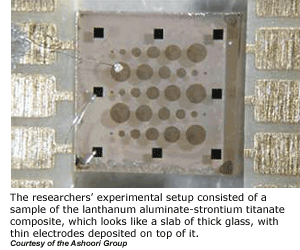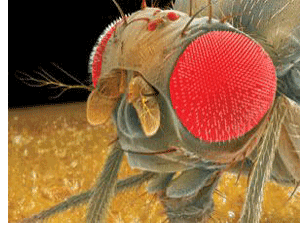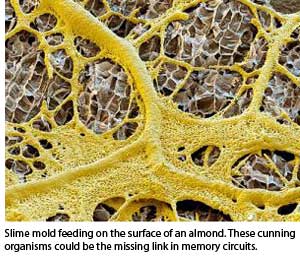Sweating the Small Stuff
Recent research news from
the front lines of the nanotech/biotech/communications revolution:
5/25/11: World record in ultra-rapid data transmission: 26 TB/sec
5/05/11: Transistors Reinvented Using New 3-D Structure
4/14/11: Flowing electrons magnetize graphene
3/04/11: Zinc peels off single layers of graphene
2/16/11: Carbon nanotube transistors could lead to inexpensive, flexible electronics
1/21/11: Unexpected Properties Unveiled in Superconducting Material
1/07/11: Spinning Nano Yarns:
A method for turning powders into fibers has many potential applications
12/17/10: The Pioneer Anomaly, a 30-Year-Old Cosmic Mystery, May Be Resolved At Last
12/03/10: Electricity and Light in One Chip
12/01/10: How to create temperatures below absolute zero
12/01/10: Making Graphene Nanomachines Practical
11/29/10: Can Carbon Put Copper Down for the Count?
11/17/10: Antimatter atom trapped for first time
11/15/10: Giant Faraday rotation spotted in graphene
11/5/10: Nanoribbons make good memories
11/03/10: Star Wars 'telepresence' tantalisingly close
11/01/10: Physicists Build Diode for Electromagnetic Waves
10/14/10: Hybrid qubits closer to reality
10/14/10: Phonons tunnel across the vacuum
9/23/10: Graphene makes "supercapacitor"
9/03/10: Graphene transistor beats speed records
7/17/08: Strongest Material Ever Tested
7/17/08: Researchers have controlled the position of a single electron in a silicon circuit
7/09/08: Nanotubes Hold Promise for Next-Generation Computing
7/02/08: Nanotech Produces Bizarre "Flat" Atom, Hailed as Quantum Computing Breakthrough
6/11/08:"Electron turbine" could print designer molecules
5/20/08: Looking into Live Cells at Nanoscale Resolution
5/02/08: Graphene-based Gadgets May Be Just Years Away
4/30/08: Scientists Create First Memristor: Missing Fourth Electronic Circuit Element
4/29/08: 'Sticky Nanotubes' Hold Key To Future Technologies
4/24/08: Simple 'superlens' sharpens focusing power
4/18/08: Tuning Terahertz
4/17/08: Tiny robotic hand has the gentlest touch
4/17/08: Graphene: Atom-thick material runs rings around silicon
3/26/08: Bringing Light to Computers
3/04/08: Nanotube Radio
2/15/08: Nanowire arrays think big
2/12/08: Casting a long line
2/09/08: Hearing the sound of quantum drums
2/04/08: A memory breakthrough
1/16/08: DNA "fabricator" constructs walking DNA
1/03/08: The spintronics challenge
|
 Toward faster transistors Toward faster transistors
MIT physicists discovered a new physical phenomenon that could eventually lead to the first increases in computers' clock speed since 2002.
In the 1980s and '90s, competition in the computer industry was all about "clock speed" — how many megahertz, and ultimately gigahertz, a chip could boast. But clock speeds stalled out almost 10 years ago: Chips that run faster also run hotter, and with existing technology, there seems to be no way to increase clock speed without causing chips to overheat.
In this week's issue of the journal Science, MIT researchers and their colleagues at the University of Augsburg in Germany report the discovery of a new physical phenomenon that could yield transistors with greatly enhanced capacitance — a measure of the voltage required to move a charge. And that, in turn, could lead to the revival of clock speed as the measure of a computer's power.
Full story: http://web.mit.edu/newsoffice/2011/faster-transistors-physics-0513.html
 Fly sniffs molecule's quantum vibrations Fly sniffs molecule's quantum vibrations
How does a nose generate the signals that the brain registers as smell? The conventional theory says it's down to the different shapes of smelly molecules. But fruit flies have now distinguished between two molecules with identical shapes, providing the first experimental evidence to support a controversial theory that the sense of smell can operate by detecting molecular vibrations.
The noses of mammals, and the antennae of flies, are lined with different folded proteins that form pocket-shaped "receptors". It has been generally assumed that a smell arises when an odour molecule slides into a receptor like a key in a lock, altering the receptor's shape and triggering a cascade of chemical events that eventually reach the brain. But this "shape" theory has limitations. For one, it can't easily explain why different molecules can have very similar smells.
In 1996, Luca Turin, a biophysicist now at the Massachusetts Institute of Technology, proposed a solution. He revived a theory that the way a molecule vibrates can dictate it odour, and came up with a mechanism to explain how this might work.
Full story: http://www.newscientist.com/article/dn20130-fly-sniffs-molecules-quantum-vibrations.html
 Physicists discover new quantum state of water Physicists discover new quantum state of water
Water's strange and life-giving qualities could be at least partly explained by quantum mechanics. That is the claim being made by a group of physicists in the UK and the US, who have made extremely sensitive measurements of the protons in tiny samples of water and have found that these protons behave very differently to those in much larger sample.
Full story: http://physicsworld.com/cws/article/news/45037
 Memristor Minds: The Future of Artificial Intelligence. Memristor Minds: The Future of Artificial Intelligence.
EVER had the feeling something is missing? If so, you're in good company. Dmitri Mendeleev did in 1869 when he noticed four gaps in his periodic table. They turned out to be the undiscovered elements scandium, gallium, technetium and germanium. Paul Dirac did in 1929 when he looked deep into the quantum-mechanical equation he had formulated to describe the electron. Besides the electron, he saw something else that looked rather like it, but different. It was only in 1932, when the electron's antimatter sibling, the positron, was sighted in cosmic rays that such a thing was found to exist.
In 1971, Leon Chua had that feeling. A young electronics engineer with a penchant for mathematics at the University of California, Berkeley, he was fascinated by the fact that electronics had no rigorous mathematical foundation. So like any diligent scientist, he set about trying to derive one.
And he found something missing: a fourth basic circuit element besides the standard trio of resistor, capacitor and inductor. Chua dubbed it the "memristor". The only problem was that as far as Chua or anyone else could see, memristors did not actually exist.
Except that they do. Within the past couple of years, memristors have morphed from obscure jargon into one of the hottest properties in physics. They've not only been made, but their unique capabilities might revolutionise consumer electronics. More than that, though, along with completing the jigsaw of electronics, they might solve the puzzle of how nature makes that most delicate and powerful of computers - the brain.
Full story: http://www.newscientist.com/article/mg20327151.600-memristor-minds-the-future-of-artificial-intelligence.html?page=1
Strongest Material Ever Tested
Graphene, praised for its electrical properties, has been proven the strongest known materials.
James Hone compares his test to stretching a piece of plastic wrap over the top of a coffee cup, and measuring the force that it takes to puncture it with a pencil. If he could get a large enough piece of the material to lay over the top of a coffee cup, he says, graphene would be strong enough to support the weight of a car balanced atop the pencil.
Strongest material
By depressing a sharp diamond probe into graphene until it broke, researchers established that the material is the strongest ever tested. This image, an illustration, shows the atomic structure of graphene, which is one atom thick and made up of carbon and hydrogen arranged in a chicken-wire-like me
|

